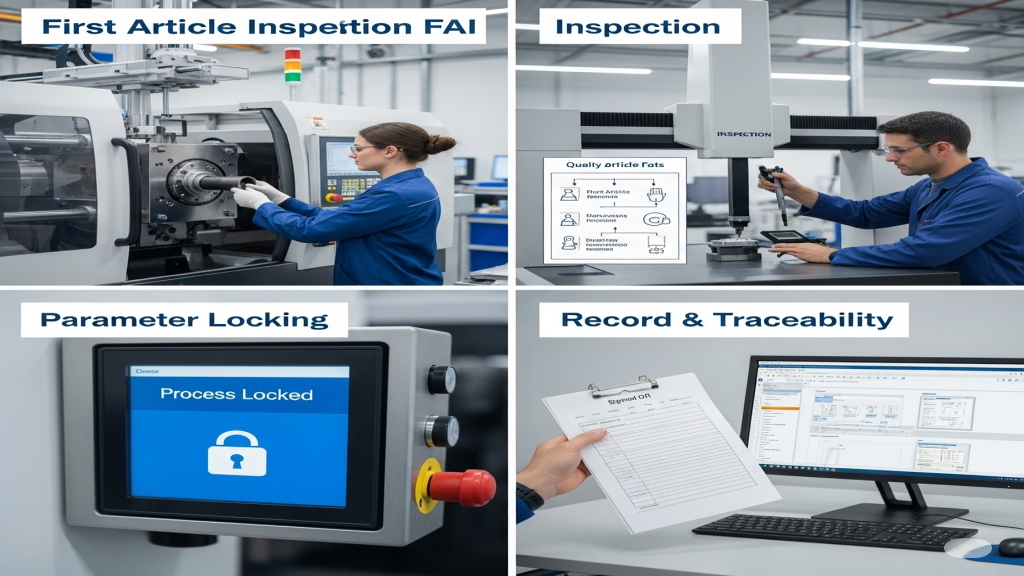Introduction

Quality control runs through the entire injection molding process, ensuring product consistency and stability. Any looseness in QC can amplify risks across the production line. It’s not just about inspection—it’s strategic process management.
Our QC system goes beyond traditional inspection, focusing on defect prevention. Precise process control and strict standards are the backbone of stable injection molding.
Is First Article Well Controlled?

First article approval is the first checkpoint for mass production quality. It validates process stability and sets the benchmark for the entire batch. Any small deviation here may cascade into major downstream issues.
- First Article Policy: Ensures mold settings and parameters are standardized.
- Parameter Lock-in: After approval, settings are locked to avoid manual changes.
- Standardized Samples: All inspections follow uniform sample standards.
- Accountability Tracking: Every first article step is logged with responsible personnel.
First article inspection is the first line of defense against errors.
Is In-Process Monitoring Consistent?

A stable molding process depends on continuous monitoring of parameter fluctuations. Real-time data helps identify abnormalities during molding. Our QC team is equipped with digital tools for full-batch process traceability.
- MES Integration: Ensures every step is digitally tracked.
- Trend Analysis: Tracks fluctuation in key parameters like temperature and pressure.
- Auto Alert System: Flags issues via auto alerts.
- Dynamic Patrols: QC performs scheduled checks at critical stations.
Process monitoring ensures instant response to any deviation.
How Do We Ensure Fast & Accurate Response?

Once an issue is detected, response speed and quality determine the scope of impact. Our QC process includes fast communication channels for immediate action. Corrective action is not just repair—it’s process optimization.
- Standard Response Workflow: All issues are prioritized and addressed quickly.
- Root Cause Analysis: Tools like 5Why and fishbone diagrams help pinpoint causes.
- Short + Long-Term Solutions: Combines temporary fixes with permanent prevention.
- Cross-Functional Teams: QC, process, and production work together swiftly.
Response isn’t just recovery—it’s the start of smarter processes.
Comparison of QC Methods
|
QC Method |
Frequency |
Manual/Auto |
Response Time |
Cost |
Traceability |
Process Stage |
Risk Level |
| First Article | Per Batch | Manual | Fast | Low | Medium | Initial | Medium |
| Routine Patrols | Hourly | Manual | Moderate | Mid | Medium | Middle Stage | High |
| MES Monitoring | Real-Time | Automated | Fast | High | High | Full Process | Low |
| Response System | Real-Time | Manual+Auto | Fast | Mid | High | Full Process | High |
Extension
As customer demands for reliability grow, QC’s role extends beyond traditional inspection. We focus on material and process control from the source, embedding quality into every step.
Digitization is transforming QC from reactive inspection to proactive analysis. Our technical accumulation gives us a competitive edge in client service. By building a visualized quality platform, we offer customers greater transparency and confidence.
1.Source Control: Vetting suppliers to improve material stability.
2.In-Process Limits: Defining key control values for every stage.
3.Data-Driven: Real-time collection feeds into big data models.
4.Client Visibility: Remote access to product quality records.
Conclusion
Efficient QC is not a bottleneck—it’s the driver for quality breakthroughs. Through standardization, visualization, and responsive systems, we position QC as the guardian of the production line. Quality is not tested out, it’s built-in through control. Moving forward, we will continue upgrading our QC systems to deliver higher value to our clients.
For expert assistance in implementing for your production needs, visit our resource center or contact us. Let’s help you scale up your manufacturing with precision and efficiency!
Post time: Jul-15-2025
